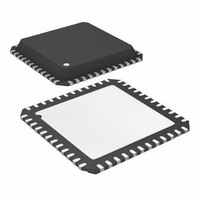AT32UC3B164-Z1UT Atmel, AT32UC3B164-Z1UT Datasheet - Page 28

AT32UC3B164-Z1UT
Manufacturer Part Number
AT32UC3B164-Z1UT
Description
IC MCU AVR32 64KB FLASH 48-QFN
Manufacturer
Atmel
Series
AVR®32 UC3r
Specifications of AT32UC3B164-Z1UT
Core Processor
AVR
Core Size
32-Bit
Speed
60MHz
Connectivity
I²C, IrDA, SPI, SSC, UART/USART, USB
Peripherals
Brown-out Detect/Reset, DMA, POR, PWM, WDT
Number Of I /o
28
Program Memory Size
64KB (64K x 8)
Program Memory Type
FLASH
Ram Size
16K x 8
Voltage - Supply (vcc/vdd)
1.65 V ~ 1.95 V
Data Converters
A/D 6x10b
Oscillator Type
Internal
Operating Temperature
-40°C ~ 85°C
Package / Case
48-QFN Exposed Pad
Processor Series
AT32UC3x
Core
AVR32
Data Bus Width
32 bit
Data Ram Size
16 KB
Interface Type
2-Wire, SPI, USART
Maximum Clock Frequency
60 MHz
Number Of Programmable I/os
28
Number Of Timers
3
Maximum Operating Temperature
+ 85 C
Mounting Style
SMD/SMT
3rd Party Development Tools
EWAVR32, EWAVR32-BL
Development Tools By Supplier
ATAVRDRAGON, ATSTK500, ATSTK600, ATAVRISP2, ATAVRONEKIT, ATEXTWIFI, ATEVK1101
Minimum Operating Temperature
- 40 C
On-chip Adc
10 bit, 6 Channel
Package
48QFN EP
Device Core
AVR32
Family Name
AT32
Maximum Speed
60 MHz
Operating Supply Voltage
1.8|3.3 V
For Use With
ATSTK600-TQFP48 - STK600 SOCKET/ADAPTER 48-TQFPATAVRONEKIT - KIT AVR/AVR32 DEBUGGER/PROGRMMR770-1008 - ISP 4PORT ATMEL AVR32 MCU SPIATEVK1101 - KIT DEV/EVAL FOR AVR32 AT32UC3B
Lead Free Status / RoHS Status
Lead free / RoHS Compliant
Eeprom Size
-
Lead Free Status / Rohs Status
Details
Available stocks
Company
Part Number
Manufacturer
Quantity
Price
Part Number:
AT32UC3B164-Z1UT
Manufacturer:
ATMEL/爱特梅尔
Quantity:
20 000
6.5.5
32059K–03/2011
Entry Points for Events
status register. Upon entry into Debug mode, hardware sets the SR[D] bit and jumps to the
Debug Exception handler. By default, Debug mode executes in the exception context, but with
dedicated Return Address Register and Return Status Register. These dedicated registers
remove the need for storing this data to the system stack, thereby improving debuggability. The
mode bits in the status register can freely be manipulated in Debug mode, to observe registers
in all contexts, while retaining full privileges.
Debug mode is exited by executing the retd instruction. This returns to the previous context.
Several different event handler entry points exists. In AVR32UC, the reset address is
0x8000_0000. This places the reset address in the boot flash memory area.
TLB miss exceptions and scall have a dedicated space relative to EVBA where their event han-
dler can be placed. This speeds up execution by removing the need for a jump instruction placed
at the program address jumped to by the event hardware. All other exceptions have a dedicated
event routine entry point located relative to EVBA. The handler routine address identifies the
exception source directly.
AVR32UC uses the ITLB and DTLB protection exceptions to signal a MPU protection violation.
ITLB and DTLB miss exceptions are used to signal that an access address did not map to any of
the entries in the MPU. TLB multiple hit exception indicates that an access address did map to
multiple TLB entries, signalling an error.
All external interrupt requests have entry points located at an offset relative to EVBA. This
autovector offset is specified by an external Interrupt Controller. The programmer must make
sure that none of the autovector offsets interfere with the placement of other code. The autovec-
tor offset has 14 address bits, giving an offset of maximum 16384 bytes.
Special considerations should be made when loading EVBA with a pointer. Due to security con-
siderations, the event handlers should be located in non-writeable flash memory, or optionally in
a privileged memory protection region if an MPU is present.
If several events occur on the same instruction, they are handled in a prioritized way. The priority
ordering is presented in Table 6-4. If events occur on several instructions at different locations in
the pipeline, the events on the oldest instruction are always handled before any events on any
younger instruction, even if the younger instruction has events of higher priority than the oldest
instruction. An instruction B is younger than an instruction A if it was sent down the pipeline later
than A.
The addresses and priority of simultaneous events are shown in Table 6-4. Some of the excep-
tions are unused in AVR32UC since it has no MMU, coprocessor interface, or floating-point unit.
AT32UC3B
28













